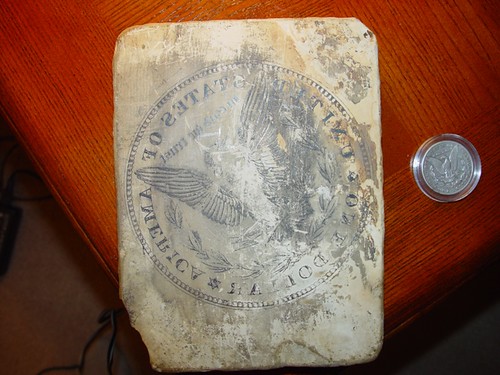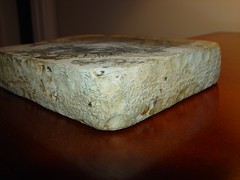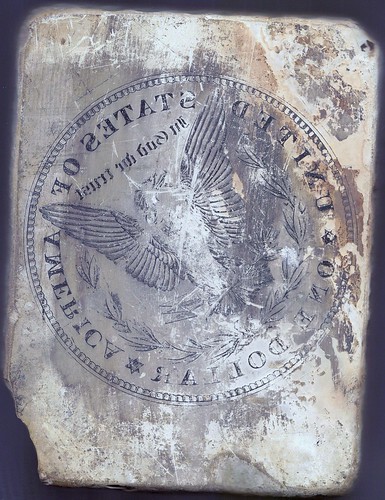
PREV ARTICLE
NEXT ARTICLE
FULL ISSUE
PREV FULL ISSUE
HAS EARLY ARTWORK FOR THE MORGAN DOLLAR BEEN FOUND?Web site visitor Steve Matzke writes: I am emailing you on behalf of a friend to determine what this item is. What he has is a carved, etched reverse of a Morgan Silver dollar on some sort of plaster or clay stone and it is considerably larger than the original coin. It appears to be a period piece and has damage to the image (it looks like someone was trying to destroy it by putting a slash through it.) It is original and has the sculptors’ original measurement markings. It appears to be an galvano. Is there are market for items like these? Any assistance is greatly appreciated!   I wasn't quite sure what this item is, but it I told Steve it did not look anything like a galvano to me. I guessed the stone was once used in printing an image of the coin. I forwarded the images to Dick Johnson and he agree that it certainly isn't a galvano. But what is it? Steve forwarded the following scan which shows more detail. Click here to view a larger version on Flickr: http://www.flickr.com/photos/coinbooks/3224454992/sizes/o/ . -Editor  Steve writes: Steve writes: Since the attached image was scanned and not photographed, you can explode to very close magnification to see the fine detail in the engraving relief and the ink/ paint work that was applied. The ink lines had to be applied by hand as the ink would have filled the small cracks of the relief if it had been put on by a brush. When you look closely at the talon, head and wing areas of the eagle, you can see the great attention someone took to detail to even the smallest points of the engraving and to the design. I would think that this was not done by someone just wanting to use it as a picture of sorts, but someone who was trying to show what the conceptual design would look like down to the finest detail. The engravers layout marks in the corners for size. The design is exactly 6 inches in diameter measured from the outer most ink circle. An actual Morgan dollar is 1.5 inches across so this would make the design exactly a 4:1 ratio of the coin. The entire piece measures approximately 6 and 3/8 inches wide by approx. over 8 1/2 inches tall. It is over 2 inches thick and weighs approximately 3-5 lbs (or more as it has never been weighed yet) The indentation mark at the south right corner is a thumbprint in the medium. There are finger impressions (not shown) all along the top edge of the piece. It is if someone pressed (or poured?) in into a mold then pulled it out of the mold then applying the ink medium over the engraving. Steve also forwarded images to other numismatists, including Julian Leidman. Julian writes: My feeling is that it is part of the mint process. I forwarded the image to Michael Fey, and he thought that it looked OK as well. One of the reasons that I think it is OK is because it is an 8 tail feather reverse. Michael said almost the same thing, except he referred to the parallel arrows. The only way to get an accurate value is to auction it and I told him that I would be happy to represent the owner in getting it properly placed. If Julian and Morgan Dollar expert Michael Fey think this item could have a connection to Morgan's dollar design, then Steve's friend may have something of value. If not, it's just an interesting door stop or boat anchor. But I agree with Julian that a public auction is the only way to determine the true value of an unusual item such as this. So - are any of our readers familiar with the tools and processes used by coin designers in the 1870s? Is such a design on stone a typical part of the process? For more information about this piece, Steve can be contacted at stevematzke@gmail.com . -Editor Wayne Homren, Editor The Numismatic Bibliomania Society is a non-profit organization promoting numismatic literature. See our web site at coinbooks.org. To submit items for publication in The E-Sylum, write to the Editor at this address: whomren@gmail.com To subscribe go to: https://my.binhost.com/lists/listinfo/esylum All Rights Reserved. NBS Home Page Contact the NBS webmaster 
|